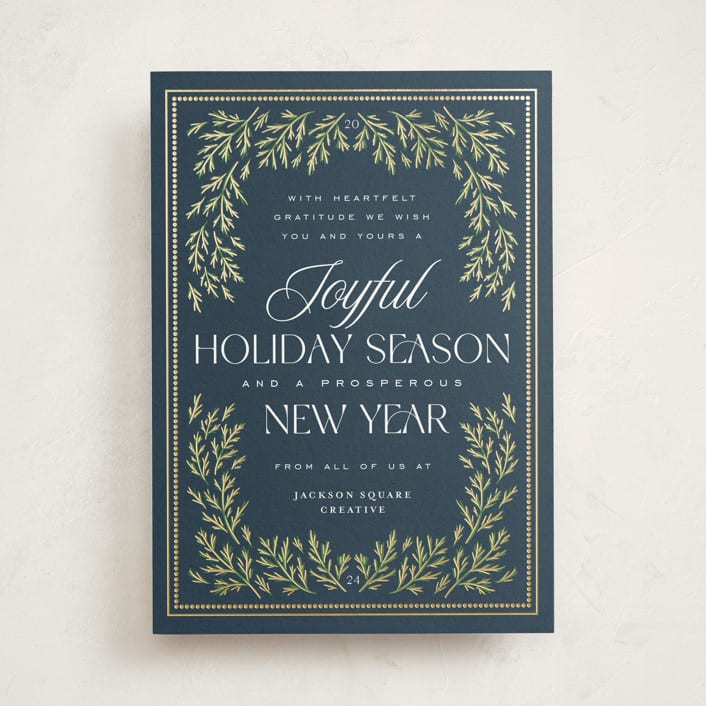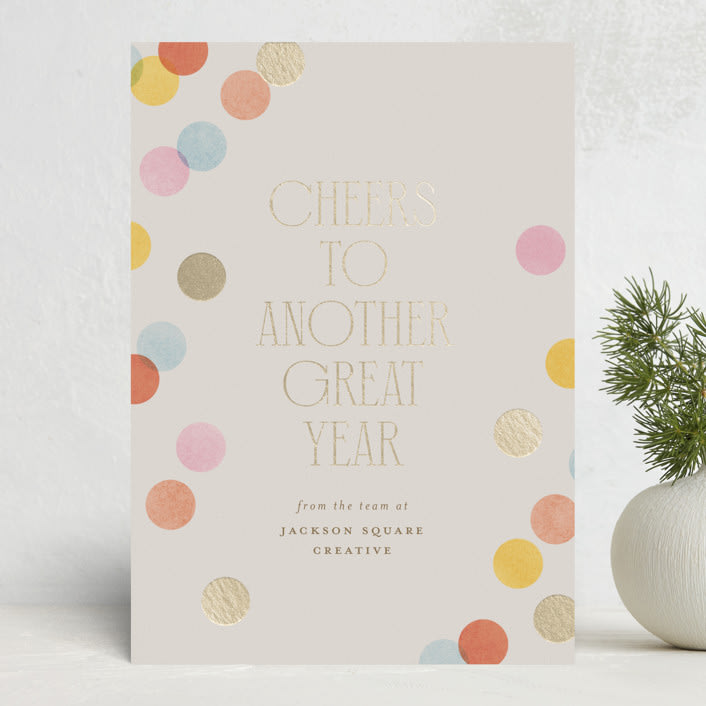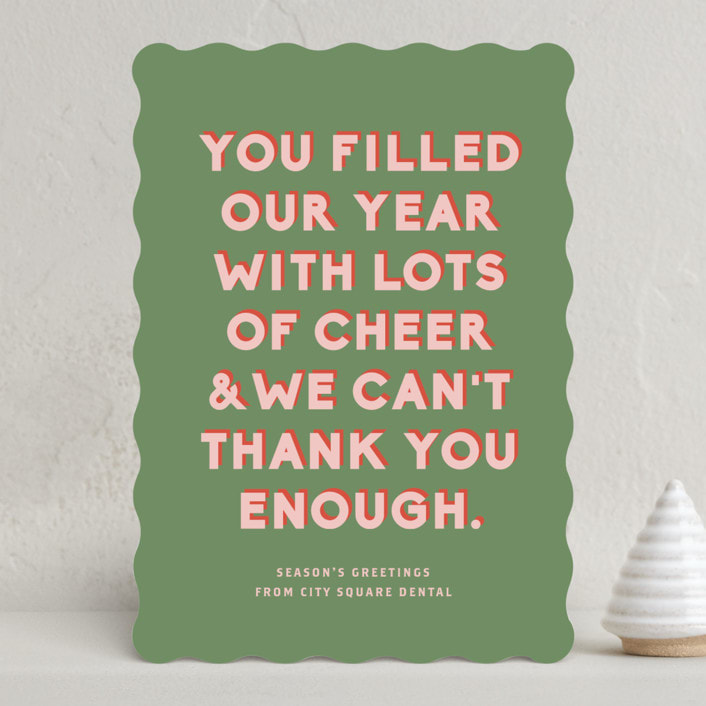Key Takeaways:
- Sending business holiday cards strengthens professional relationships by showcasing genuine appreciation and your brand's personality.
- Timing is crucial — mail cards between late November and early December to ensure they arrive during the festive season without getting lost in the holiday rush.
- Personalization, inclusive messaging, and thoughtful design choices make your holiday cards stand out and leave a lasting impression on recipients.
Sending business holiday cards can feel daunting — in addition to making sure they get out on time, you want to make sure the cards and message you choose say “Thanks for being awesome this year” without going too casual or overly salesy.
So consider this etiquette breakdown your friendly guide, not a list of stiff rules. With these tips in mind, you’ll be more than prepared to send a holiday card that helps strengthen relationships, express genuine appreciation, and keep your company top of mind with clients, peers, and vendors. (And, if you want to send something people will actually want to keep on their desk, look at Minted's business holiday cards for inspiration!)
Why Sending Business Holiday Cards Matters
When you send out business holiday cards, you’re taking the time to strengthen relationships. You’re showing clients, partners, and colleagues that they matter enough for you to go above and beyond; that extra effort builds loyalty, trust, and goodwill. It’s also your chance to show off your company’s personality with bold, modern designs that highlight your creative side or warm, traditional styles that emphasize reliability. Your card becomes a little snapshot of who you are as a brand.
A well-designed business holiday card can live on someone’s desk or mantle all season long, keeping you top of mind while showing you care. This thoughtful gesture can complement your other holiday outreach and help you stand out positively. It creates a moment people notice and appreciate, one that can spark future collaborations and keep important relationships strong all year long.
When Is the Best Time to Send Business Holiday Cards?
Timing your business holiday cards just right means your greeting lands when people can enjoy it, not when it’s buried under a mountain of December mail. You’ll want to aim for the sweet spot between the week after Thanksgiving and early December, when everyone’s feeling festive but not overwhelmed. This way, your card arrives at the perfect moment to make someone smile.
- Send cards between the last week of November and the first week of December so they reach desks before the seasonal rush takes over.
- Skip sending too early in November, as your card could get forgotten, and avoid waiting until mid-December, when it might get lost in year-end mail.
- Plan for postal delays by giving at least two weeks for delivery during peak season.
- For international recipients, send a week earlier to allow for customs and longer transit times.
- Start designing and ordering in October, so you have plenty of time to hand-sign each one, write a personalized note to those you’re sending them to, and add on any extra touches like envelope liners or wax seals.
Who to Send Business Holiday Cards To and Who Should Sign Them
Think about your recipients in three groups so it’s easier to plan your list:
- Inside your company: colleagues in other departments and teammates you work closely with
- Outside partners: key clients, business partners, vendors, and suppliers you collaborate with
- Past contacts: former clients or partners you’d like to reconnect with
Make it personal so each person feels seen. In addition to the greeting on your card, handwrite a personal note that mentions a project you worked on together or something you’ve talked about recently. Always double-check names and addresses — getting them right shows you care.
Who Should Sign Business Holiday Cards
When it’s time to sign your business holiday cards, think about what will feel warm and genuine. If you’re sending on behalf of the whole business, have the whole leadership team or the main contact sign. You could have everyone sign if you’re part of a small team.
Pro tip: Have one person write the personal notes so everything feels consistent, then pass cards around to whoever you decide to include as singers to finish them off.
What to Write in a Business Holiday Card
Figuring out what to write in your business holiday card doesn’t have to be stressful. You want your words to feel warm, genuine, and professional, showing your appreciation while still feeling personal. We’ve compiled a few of our most important tips for writing greetings here, but for more ideas, check out our full guide to nailing your business holiday cards.
- Choose inclusive greetings like "Happy Holidays," "Season's Greetings," or "Wishing you joy this season" instead of specific religious references to welcome everyone on your list.
- Express genuine gratitude by mentioning specific partnerships, projects, or support from the past year: a simple "We appreciate your collaboration on the Johnson project" feels more personal than generic appreciation.
- Keep messages concise with just one to two sentences that pack a punch; brief, heartfelt notes are more memorable than lengthy paragraphs.
- Add a creative touch that reflects the brand's personality, a playful pun related to the industry, or a hand-drawn doodle that shows extra thought.
- Focus on the relationship rather than promoting services, save the sales pitch for January, and let appreciation shine through instead.
- Include a positive note about the future, like "Looking forward to another great year together," to reinforce commitment to the partnership.
Email vs. Printed: What's the Right Format?
When deciding between printed and digital business holiday cards, think about the impression you want to leave. Printed cards give you something tangible to put in someone’s hands — something they can keep on their desk, pin to a board, or save in a drawer. They show you took the extra time and care and give you more ways to show off your brand’s style with paper textures, finishes, and customizable stationery that feels uniquely you.
Digital cards, on the other hand, are perfect if your team is remote, you want to keep things eco-friendly, or you’re looking for a faster, more budget-friendly option — you can design and send them in under a week and still make them look polished and on-brand.
A lot of businesses find that a mix works best. You might send printed cards to your most important clients and long-term partners, where the extra care matters, and use digital versions for vendor networks, casual contacts, or larger outreach lists. This way, you’re tailoring the format to the relationship, making each card feel intentional while still connecting with everyone who matters to your business.
Common Etiquette Mistakes to Avoid
It’s easy to make small mistakes with your business holiday cards — things that can make your thoughtful gesture feel awkward or less personal. To help you avoid those slip-ups, here are a few tips to keep in mind when sending yours this season.
- Misspelling names instantly makes your card feel less personal. Take time to check every detail before mailing.
- Over-branding or making the design feel like an ad can take away from the spirit of the gesture. Keep your card looking and feeling like a genuine holiday greeting rather than a marketing piece.
- Using imagery or symbols that don’t fit your recipient’s background can feel out of touch. Stick with neutral, seasonally inspired visuals unless you know their specific preferences.
- Sending your cards too late can undermine the impact of your effort. Aim to have them arrive early in the season so they are enjoyed throughout the holidays.
- Skipping quality checks like reviewing paper choice, printing, and envelope condition can make the card feel rushed. Investing in these details shows you value the relationship.
- Leaving off your return address removes a simple opportunity for them to respond or update their contact information.
Frequently Asked Questions (FAQs) about Business Holiday Card Etiquette
Got questions about navigating the world of business holiday cards? You're not alone. Here are answers to the most common questions when you're trying to strike the perfect balance between professional and personal.
What exactly is business holiday card etiquette, and why does it matter?
Business holiday card etiquette refers to the guidelines for sending thoughtful, professional greetings that respect your recipients’ time, values, and traditions. Following proper etiquette matters because a well-crafted card can strengthen relationships and express genuine appreciation, while a poorly executed one might feel overly promotional or culturally insensitive.
What's the real reason behind sending cards in early December?
The real reason for sending business holiday cards in early December is to reach people when they’re in the holiday spirit but before their schedules and mailboxes become overloaded. Sending too early risks your card being overlooked in Thanksgiving week, while sending too late means it could arrive after people have mentally moved on to the new year (or are on vacation).
How should I handle addressing and personalizing my cards?
When addressing and personalizing business holiday cards, use full names and proper titles rather than generic greetings like “Dear Valued Customer.” Adding a personal touch, such as referencing a recent project or including a handwritten note, helps your card stand out from other corporate greetings and shows that you’ve put thought into the connection.
Can I incorporate my company's branding without looking too promotional?
You can incorporate your company’s branding into business holiday cards by using subtle design elements like brand colors, typography, or a small logo. The key is to keep the focus on gratitude rather than marketing, so the card feels like a genuine thank-you rather than an advertisement.
How do I ensure my design choices are culturally sensitive?
To ensure your business holiday card design is culturally sensitive, choose inclusive greetings such as “Happy Holidays” or “Season’s Greetings,” and avoid religious symbols unless you know the recipient’s preferences. Opt for winter themes, nature motifs, or abstract designs that can be appreciated by people of all backgrounds.
Should I go with handwritten messages or stick to printed text?
When deciding between handwritten messages and printed text for business holiday cards, consider using both. A printed message provides a professional look, while a handwritten signature or short personal note adds warmth and individuality. For large mailings, focus your handwritten notes on your most important relationships while keeping printed messages friendly and professional for everyone else.
Make Your Business Holiday Cards as Unique as Your Business
Getting your business holiday card etiquette right means finding the sweet spot between professionalism and personality. Every choice you make reflects your brand’s values and attention to detail. The best cards feel genuine, not generic, and that’s where customizable stationery shines. When you tailor colors, fonts, and layouts to match your brand’s aesthetic, you create something recipients want to display instead of tuck away.
Minted’s artist-designed business holiday cards and stationery accessories help you add those thoughtful finishing touches that make your design stand out. These details turn your holiday greeting into more than a seasonal formality, making it a keepsake.










